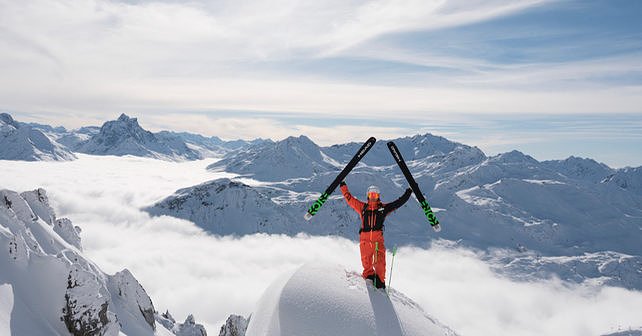Skiing off-piste requires good skiing skills and experience. Since the snow conditions can be very varied (crust, crud, slush, powder, ice) as well as the terrain (plateaus, forests, steep terrain), a good off-piste skier must have good freeride technique.
Off-piste skiing takes technique, a lot of versatility, and certainly a few powder skiing tips don't hurt. Here’s a list of small recommendations to ski off-piste while having fun!
3 rules to keep in mind when skiing off-piste
- Be in control of your skis, speed, whatever the snow conditions and visibility;
- Choose terrain and snow conditions suitable to your technical level, physical condition, and experience;
- Keep your mind sharp, on the alert, and constantly listening.
Off-piste skiing in a group
Another rule to follow is to always start in a group when going off-piste. And always having read the Regional Avalanche Risk Bulletin. When you are a beginner (and not only), the most effective way to progress quickly is always to rely on an instructor or mountain guide.
Different types of off-piste skiing
We have said it before, and we will say it again, a good off-piste skier must be able to adapt to constantly changing conditions (terrain, snow quality). This means adopting different positions on skis and change skiing styles.
Here are the three main styles of off-piste skiing, that will allow you to deal with (almost) all types of snow:
- Fresh snow (light amounts) or spring snow: ski like on-piste or almost! The good news when you find these snow conditions is that the skiing technique is not much different from what you do on the slope. When there is some fresh snow (10-15 cm) with a hard bottom underneath or when you will find spring snow. You then simply have to be responsive. Precise in leaning. Look far and always ahead to anticipate hollows and control your speed. In this case: weight forward, as on the slope. In these snow conditions you will be able to attack slopes like groomed trails.
- Fresh snow (moderate amount): the music changes a bit when the amount of fresh snow increases. You have to be able to adapt to the quality and height of the fresh snow layer. In fresh snow you have to make different styles of skiing coexist. This is because we may be on narrow terrain, thus having to make tight turns, as well as on wide plains with no obstacles in front of us, or on steep terrain. The quality and height of the layer, as mentioned, changes the skiing style. Powder skiing is very physically demanding, so you need to be trained for endurance.
- On the steep: on the steep you need to be able to turn by "jumping". When the terrain is very steep and the snow hard, you need to be able to make the turns by jumping to progress downhill and change the edge and skis that are downhill. This particular technique for curving will allow you to control your speed. After you stop, plant your poles, bring your body weight on the downhill ski, wide skis and advance the ski uphill. Then load the upstream ski briefly to allow both skis to rotate. You can then cushion the landing with a slight sideways drift.
Off-piste skiing: the right equipment makes all the difference!
Finally, the equipment is crucial. Skis that are used on untracked snow are not suitable for freeride trails. Among the off-piste equipment, ski helmet (which protects the head from frequent falls) is of paramount importance and the safety kit that has become mandatory in many cases.
Acquiring good off-piste skiing technique takes time and a lot of experience to be effective in all types of conditions. If you are, therefore, fascinated by this type of activity, equip yourself with everything you need and start training with a group tour by gradually exploring the mountain on which you wish to ski.
See you on the top!
